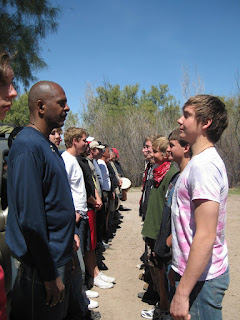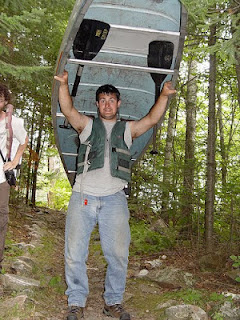This is the “silly picture” of some men and young guys taken near the Minnesota's Boundary Waters Canoe Area Wilderness, or BWCA as the locals call it. It's a guy's group from the
Boys to Men Mentoring Network of Minnesota (BTM-MN). Maybe you can't see it, but this is a true victory photo for a whole bunch of reasons.
For those that aren't familiar with the area, the BWCA is on the U.S.-Canadian border in northern Minnesota. It's part of the historic homeland of the Ojibwe people, who traveled the same waterways in birch bark canoes. Think of the BWCA as a million-acre wilderness playground, with over a thousand lakes, and over 2,200 back-country campsites. The lakes are connected by portage trails or paths between the lakes that require carrying all your gear, and the canoes, across the land separating the lakes. It's the perfect guy place, and just what's needed to heal Nature Deficit Disorder.
In past blog posts I've written about the idea of
Nature Deficit Disorder, or NDD. When young males are without older men as guides to the natural world, it's easy for them to be completely disconnected from nature. For young dudes who only know pavement, buildings, malls, and their own neighborhood, the idea of paddling a canoe across open water, cooking over a fire, and spending a few nights in the woods can be a terrifying notion. So the first victory is that these guys got a taste of this awesome wilderness area at all.
The men of BTM-MN really know how to construct this kind of an adventure. For starters, they use only background-checked men, they have conversations with parents, and they get parental release forms. The weekend prior to the actual outing, there was a training event so the young guys could get some experience with canoes, paddling technique, and, for some, just getting comfortable in and on the water. As the trip grew close, they sent out instructions on how to pack for camping and even offered scholarships for those who couldn't afford the small cost of the trip.
On launch day, nine young males and three men set out into the great wilderness, much like males have done for centuries. In the BWCA, portage distances are still measured in rods. A rod is the same as 16.5 feet. The crew managed 3 portages of 10, 70, 120 rods. That's a lot of carrying, tripping on roots, and finding your way with a canoe on your shoulders.
They finally arrived at their predetermined campsite, a physical victory to be sure. It was a beautiful location, with lots of wide rock shelves, breezes to keep bugs away, and a nearby stream to explore. They set up their tents, established the campsite, and from there the grand adventure unfolded.
An important collection of victories came from how much these (sometimes academically challenged) young guys learned. They got hands-on experience with canoeing skills, catching and cleaning fish, fire starting, bear-proofing a campsite, the use of a compass and maps, managing un-potable water, cooking, cleaning, taking a wilderness crap, and the needed teamwork to get it all done. All of that while having fun, exploring on day-long side trips, swimming, having water fights, and spending a lot of time around a campfire.
Perhaps one of the biggest victories for these young guys
was simply the time they got to spend around men.
Perhaps one of the biggest victories for these young guys was simply the time they got to spend around men. I know these particular men. Because of their big hearts and powerful intention to support young males, I'm certain they were constantly modeling important lessons in how to be a good man. I believe in addition to all the fun, the inevitable and difficult conflicts in the group were dealt with head on with patience, care, and teaching. I am also just as certain the young guys were generously and regularly praised for their many accomplishments.
Because of the trust that develops in the pack, in the quieter times around the fire it's common to have a man or young guy share some personal truth about their fears, sadness, successes, or hopes for the future. They get deep listening from the others, and in some way, are honored for their vulnerability. Because of all this, you can be sure they all came back more a band of brothers than they were before the trip.
If you and a few of your men friends want to make a big difference in young male lives, gather up some boys, pack up, and set out. The "wilderness" doesn't have to be the BWCA, and can be as close as the city park on the edge of your community. I believe males are hardwired for this kind of "heading out," and the destination is less important then your small male tribe gearing up, going "away," and having some fun together in a beautiful place.
If you'd like some support to take on this kind of outing,
give me a shout. Or you can
contact Charlie Borden, the BTM-MN coordinator for the BWCA trip. We'll give you some ideas, tell you it's easier than you think, and remind you that, with caring men showing up for boys, you just can't do it wrong.
LIKE: If you enjoy this blog, please click the "
Like" button below to support the Man-Making Facebook page!
TWEET: Send this post along to your friends or follow me on Twitter!
SUBSCRIBE: If you're not yet a subscriber to the Man-Making Blog, and you'd like to receive these posts by email 3-4 times a month, go to
this link for a free subscription.
CONTACT: Send Earl a message.



























